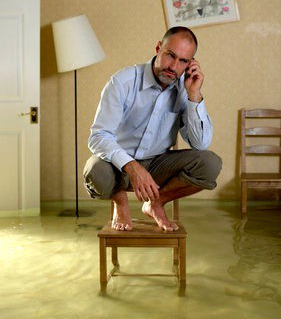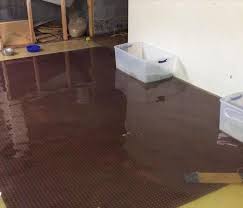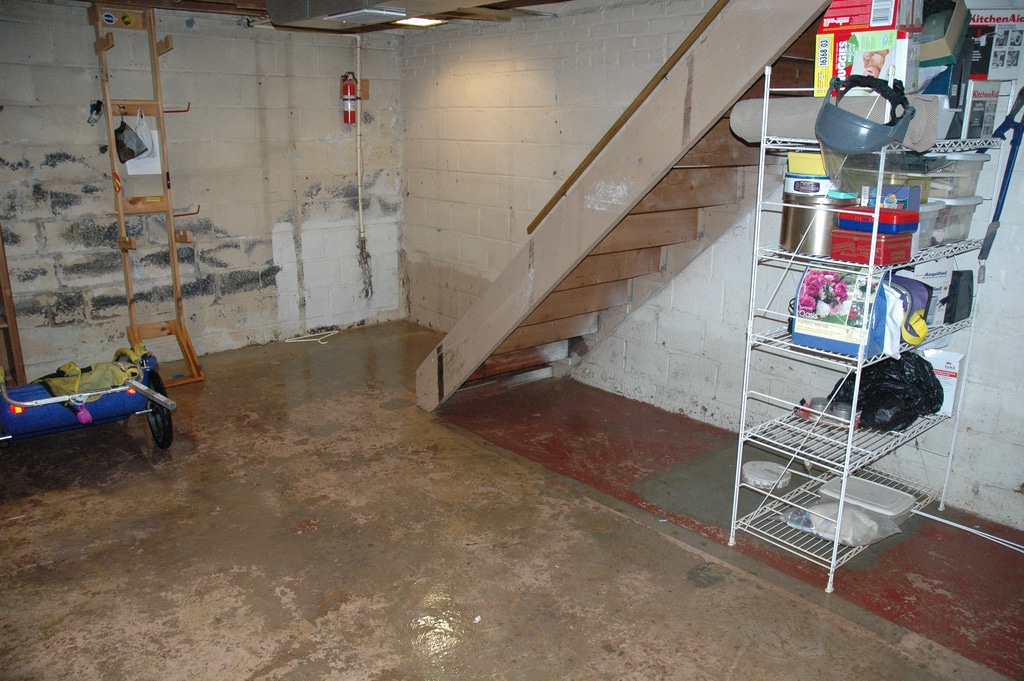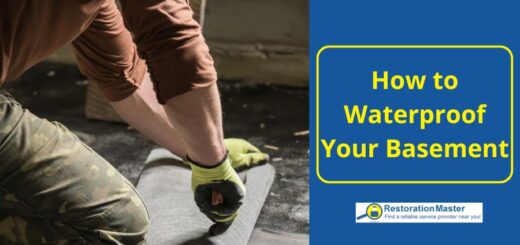How to Dry Out a Room After a Flood
Nothing can be more frustrating than to discover that one or more rooms in your home has flooded, damaging not just the structureStructure refers to the framework or components of a buildin... More, but also your belongings. This can be especially frustrating if the water has been sitting for a while and the affected area starts to smell musty. This is why it’s important to react immediately in any case of water damage, as it will only grow worse with time.
PorousPorous describes a material that contains small openings or ... More materials, like wood flooring, drywall, carpeting, and furnishings will quickly absorb water and become warped, stained, discolored, and even weakened. MoldMold is a type of fungus that grows in damp or humid conditi... More can also grow in as little as 24 hours after water or flood damage. Spreading by dispersing its sporesSpores are microscopic reproductive units of fungi or mold t... More into the air, moldMold is a type of fungus that grows in damp or humid conditi... More will continue to search for other areas with high moisture contentMoisture content is the amount of water present in a materia... More. They will also cause a number of health issues, as moldMold is a type of fungus that grows in damp or humid conditi... More sporesSpores are microscopic reproductive units of fungi or mold t... More can trigger asthma and allergies in those exposed.
What to Do After a Flood
Calling for emergency help should be your top priority. Flood cleanup professionals are available 24/7 and will respond right away to start the water extraction and dryingDrying is the process of removing moisture from materials, s... More process. And while it’s not recommended to do yourself, mild cases of flood damage can be treated using home remedies, as long as the following steps are followed:
1. Prioritize Your Safety
 Before entering the property, water damage restoration professionals are trained to inspect the property for safety hazards, including electrical or structural issues. They also always assume the water is contaminated, which is why they use personal protective equipment (PPE)Personal protection equipment (PPE) is safety gear such as g... More.
Before entering the property, water damage restoration professionals are trained to inspect the property for safety hazards, including electrical or structural issues. They also always assume the water is contaminated, which is why they use personal protective equipment (PPE)Personal protection equipment (PPE) is safety gear such as g... More.
- Inform your insurance company of the flood right away.
- Never step in any standing water or puddles if power lines are down outside the home.
- Inspect the exterior of the home before entering. Visible damage like foundation cracks can indicate a weakened property structureStructure refers to the framework or components of a buildin... More.
- Have all sewer, electric, water, and gas lines professionally inspected.
- Open the windows to improve air circulation throughout the home.
- Never force doors open, as they may be providing support to the rest of the structureStructure refers to the framework or components of a buildin... More.
- Use only battery-powered light sources.
- Never use gas-operated generators inside.
- Be careful of any insects, snakes, or other nuisance animals inside the home.
- Always wear waterproof boots, eye protection, and gloves when touching any contaminated surface.
- Make sure that both gas and electricity are off before walking in.
- Make a list and take pictures of all damaged items in the home, including the building structureStructure refers to the framework or components of a buildin... More.
2. Remove and Organize Items into Discard and Restoration Piles
All porousPorous describes a material that contains small openings or ... More, saturated items, including carpet and bedding, should be removed right away. This includes items sustaining long-term flood damage.
- Keep all items to be thrown away onsite for the insurance adjuster to document.
- All plastic, metal, and solid wood furniture can be restored. Take them outside, hose them off, clean, and sanitize them. Then let them sit to dry in the sun.
- All carpets, padding, and rugs should be thrown away because of contaminationContamination is the presence of harmful or unwanted substan... More.
- Throw away all food products present during the flood. Any canned goods can be saved, as long as the labels are removed. Just be sure to clean, sanitize, and relabel the can with the item and expiration date.
- All damaged pictures and important documents can be frozen until you have time to clean them.
- Remove the rest of the furniture to throw away.
3. Drying Process
As soon as power is restored, use high-powered fans and dehumidifiers throughout the home, running them for several weeks. Use a shovel to remove all silt and mud, followed by a garden hose to clean hard surfaces. The cleaning process should take place as soon as the water is extracted to prevent moldMold is a type of fungus that grows in damp or humid conditi... More growth.
Floors
As soon as you remove the carpet padding and/or flooring, remove the subfloorThe subfloor is the foundational layer beneath flooring mate... More right away.
- It’s probable the subfloors will swell if they were under water for long periods of time. Therefore, you will need to replace some areas.
- While you can clean and restore tile, you will need to inspect and dry the subfloorThe subfloor is the foundational layer beneath flooring mate... More.
- Generally, you cannot restore wood floors .
Walls
To prevent slow moldMold is a type of fungus that grows in damp or humid conditi... More growth, decay of wall studs, and odors, be sure to take the following steps:
- Remove all visible mud from wall studs. Then clean and disinfect the area to prevent moldMold is a type of fungus that grows in damp or humid conditi... More growth.
- It may be possible to save both paneling and plasterPlaster is a building material made of lime, gypsum, or ceme... More, but it’s important to have proper air flow to dry them out.
- All damp insulationInsulation is a material used in buildings to reduce the tra... More should be removed.
- Remove all baseboard trimTrim is the decorative or functional molding used to finish ... More.
- You may need to remove Six-inch sections at the ceiling to improve air flow within the wall.
- Remove all drywall one foot above the water line.
- Pressure wash all brick walls and replace wood and masonite siding.
 Basement
Basement
- Gradually pump out water each day to prevent permanent structural damage. If you pump the water out too quickly, the pressure from wet soil on the exterior may cause basement walls to collapse.
- Concrete is a porousPorous describes a material that contains small openings or ... More material. Therefore, you should clean, sanitize, and dry the interior foundation walls.
- A wet vacuum or pump can be rented or purchased to remove the remaining water from the property.
- It is crucial to use a dehumidifierA dehumidifier is a device that removes excess moisture from... More to remove the remaining moisture from the air spaces and structureStructure refers to the framework or components of a buildin... More behind the walls.
Flood Damage Cleanup and Dehumidification
When your property floods, there are a lot of cleanup efforts involved to limit the spread of damage and prevent moldMold is a type of fungus that grows in damp or humid conditi... More growth. As it moves throughout the property, many building materials and contents will suffer significant damage and will need immediate and detailed dryingDrying is the process of removing moisture from materials, s... More and cleaning to be restored. As these processes are long and very involved, it can be overwhelming just to look at the mess.
Thankfully, flood damage cleanup professionals are available 24/7 to respond to your first call. They will arrive right away with professional water extraction and dehumidificationDehumidification is the process of reducing and controlling ... More equipment to remove the standing water and moisture from the air spaces and affected materials. Each technician is trained, licensed, and experienced to handle the job efficiently and effectively, allowing you to get back on track as soon as possible. They will also work with your insurance company during the claims process so you can focus on personal matters.













